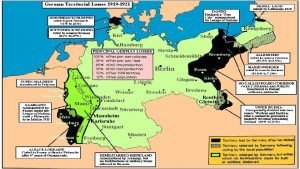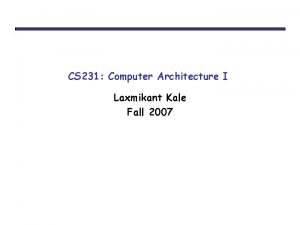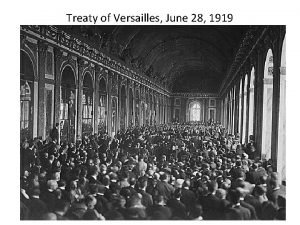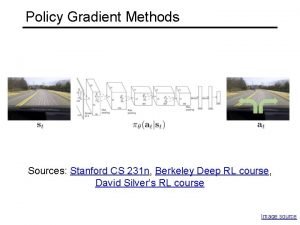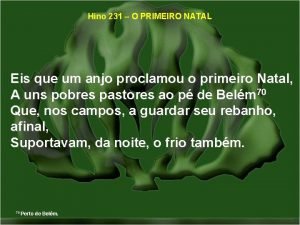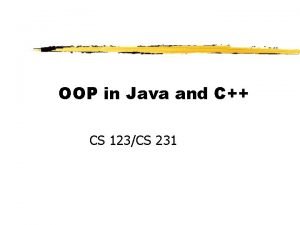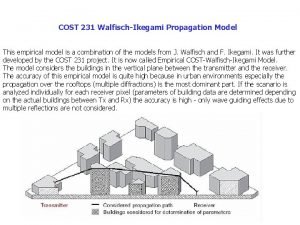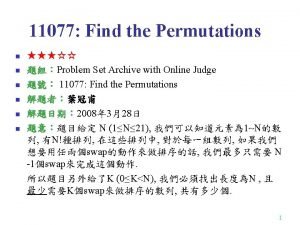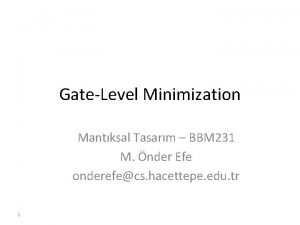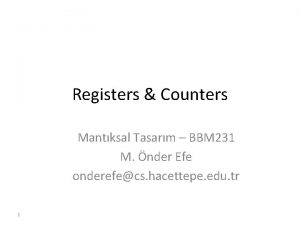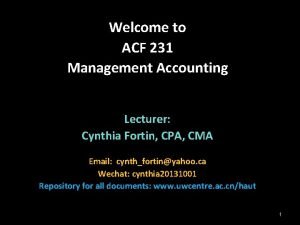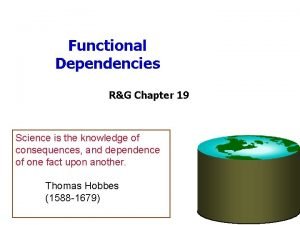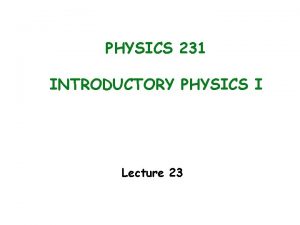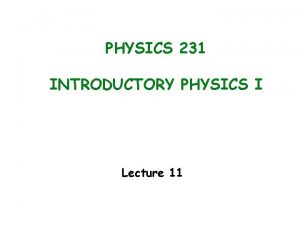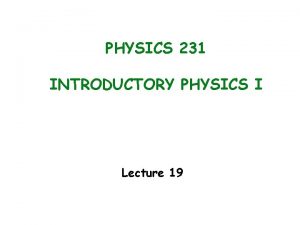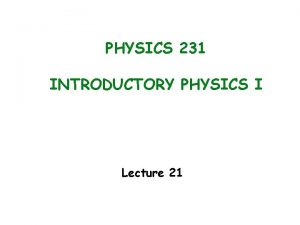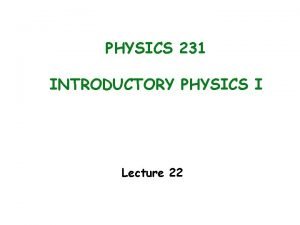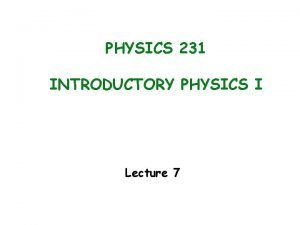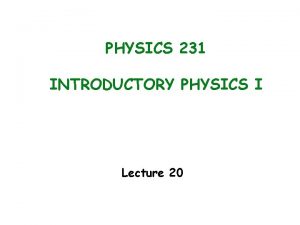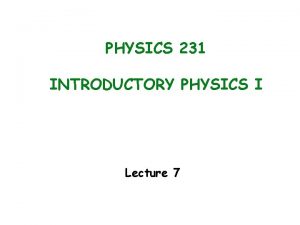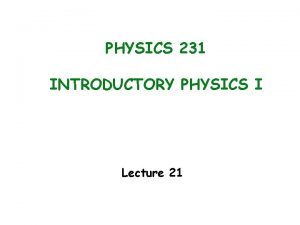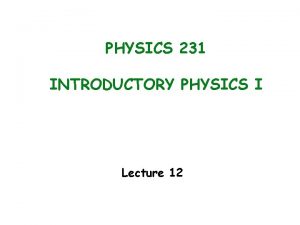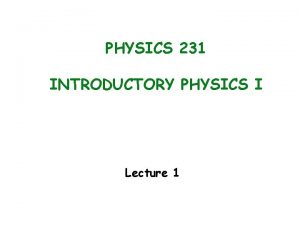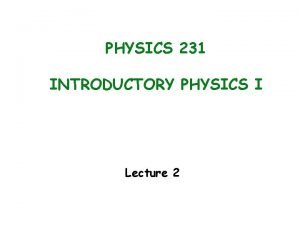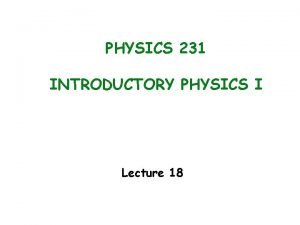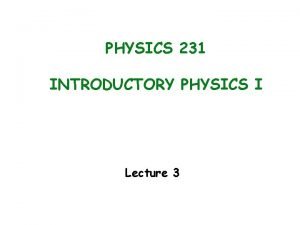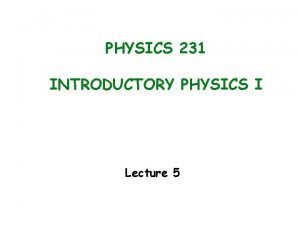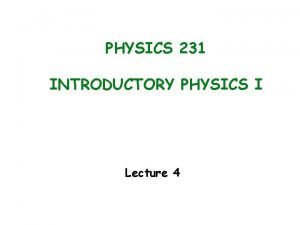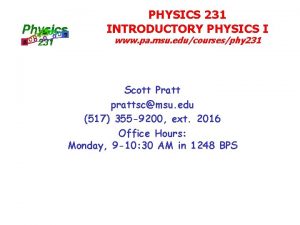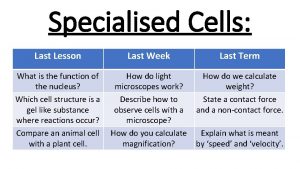PHYSICS 231 INTRODUCTORY PHYSICS I Lecture 6 Last


























- Slides: 26

PHYSICS 231 INTRODUCTORY PHYSICS I Lecture 6

Last Lecture: • • • Gravity Normal forces Strings, ropes and Pulleys Today: • Friction • Work and Kinetic Energy • Potential Energy • Conservation of Energy

Frictional Forces • RESISTIVE force between object and neighbors or the medium • Examples: • Sliding a box • Air resistance • Rolling resistance

Sliding Friction • Parallel to surface, opposing direction of motion • ~ independent of the area of contact • Depends on the surfaces in contact • Object at rest: Static friction • Object in motion: Kinetic friction

Static Friction, ƒs • Just enough force to keep object at rest. • ms is coefficient of static friction • N is the normal force f F

Kinetic Friction, ƒk • mk is coefficient of kinetic friction • Friction force opposes direction of motion • N is the normal force f F

Coefficients of Friction

Example 4. 7 The man pushes/pulls with a force of 200 N. The child and sled combo has a mass of 30 kg and the coefficient of kinetic friction is 0. 15. For each case: What is the frictional force opposing his efforts? What is the acceleration of the child? f=59 N, a=3. 80 m/s 2 / f=29. 1 N, a=4. 8 m/s 2

Example 4. 8 Given m 1 = 10 kg and m 2 = 5 kg: a) What value of ms would stop the block from sliding? b) If the box is sliding and mk = 0. 2, what is the acceleration? c) What is the tension of the rope? a) ms = 0. 5 b) a=1. 96 m/s 2 c) 39. 25 N

Example 4. 9 What is the minimum ms required to prevent a sled from slipping down a hill of slope 30 degrees? ms = 0. 577

Chapter 5 Work and Energy

Forms of Energy • Mechanical • Kinetic, gravitational • Thermal • Microscopic mechanical • Electromagnetic • Nuclear Energy is conserved!

Work • Relates force to change in energy • Scalar quantity • Independent of time

Units of Work and Energy SI unit = Joule 1 J = 1 N m = 1 kg m 2/s 2

Example 5. 0 A man holds a 50 lb box at waist level for 10 minutes. Has he done any work during this time? 120 m

Work can be positive or negative • Man does positive work lifting box • Man does negative work lowering box • Gravity does positive work when box lowers • Gravity does negative work when box is raised

Work and friction A block is pulled a distance x by constant force F. N fk F mg • • Work of of F> 0 N = 0 mg = 0 fk < 0 Work of (kinetic) frictional force is always < 0. -> It removes mechanical energy from system.

Kinetic Energy Same units as work Remember the Eq. of motion Multiply both sides by m, Work-Energy Theorem

Example 5. 1 A skater of mass 60 kg has an initial velocity of 12 m/s. He slides on ice where the frictional force is 36 N. How far will the skater slide before he stops? 120 m

Potential Energy If force depends on distance, we can define Potential Energy This must be independent of Path -> “Conservative Force” For gravity (near Earth’s surface)

Conservation of Energy Conservative forces: • Gravity, electrical, … Non-conservative forces: • Friction, air resistance… Non-conservative forces still conserve energy! Energy just transfers to thermal energy (heat)

Example 5. 2 A diver of mass m drops from a board 10. 0 m above the water surface, as in the Figure. Find his speed 5. 00 m above the water surface. Neglect air resistance. 9. 9 m/s

Example 5. 3 A skier slides down the frictionless slope as shown. What is the skier’s speed at the bottom? start H=40 m finish L=250 m 28. 0 m/s

Example 5. 4 Three identical balls are thrown from the top of a building with the same initial speed. Initially, Ball 1 moves horizontally. Ball 2 moves upward. Ball 3 moves downward. Neglecting air resistance, which ball has the fastest speed when it hits the ground? A) B) C) D) Ball 1 Ball 2 Ball 3 All have the same speed.

Example 5. 5 Two blocks, A and B (m. A=50 kg and m. B=100 kg), are connected by a string as shown. If the blocks begin at rest, what will their speeds be after A has slid a distance s = 0. 25 m? Assume the pulley and incline are frictionless. 1. 51 m/s s

Example 5. 6 Tarzan swings from a vine whose length is 12 m. If Tarzan starts at an angle of 30 degrees with respect to the vertical and has no initial speed, what is his speed at the bottom of the arc? 5. 61 m/s
 01:640:244 lecture notes - lecture 15: plat, idah, farad
01:640:244 lecture notes - lecture 15: plat, idah, farad Randy pausch last lecture summary
Randy pausch last lecture summary Visualizing and understanding recurrent networks
Visualizing and understanding recurrent networks Color 21112007
Color 21112007 German territorial losses ww1
German territorial losses ww1 Transitor
Transitor Electric field strength formula
Electric field strength formula Article 231 of the treaty of versailles
Article 231 of the treaty of versailles Standford cs231
Standford cs231 Mvcnn pytorch
Mvcnn pytorch Hinario novo cantico 231
Hinario novo cantico 231 Cs 231 n
Cs 231 n 123cs
123cs Walfisch ikegami model
Walfisch ikegami model Cs 231 n
Cs 231 n 132 213
132 213 Bbm 231
Bbm 231 Gezang 231
Gezang 231 Toastmasters timer sheet pdf
Toastmasters timer sheet pdf Draw 231 with base ten blocks
Draw 231 with base ten blocks Cs 231 n
Cs 231 n Phy 231 msu
Phy 231 msu Al quran muka surat 226
Al quran muka surat 226 Q a 1
Q a 1 Electrostatic energy
Electrostatic energy Acf 231
Acf 231 040 231 3666
040 231 3666




